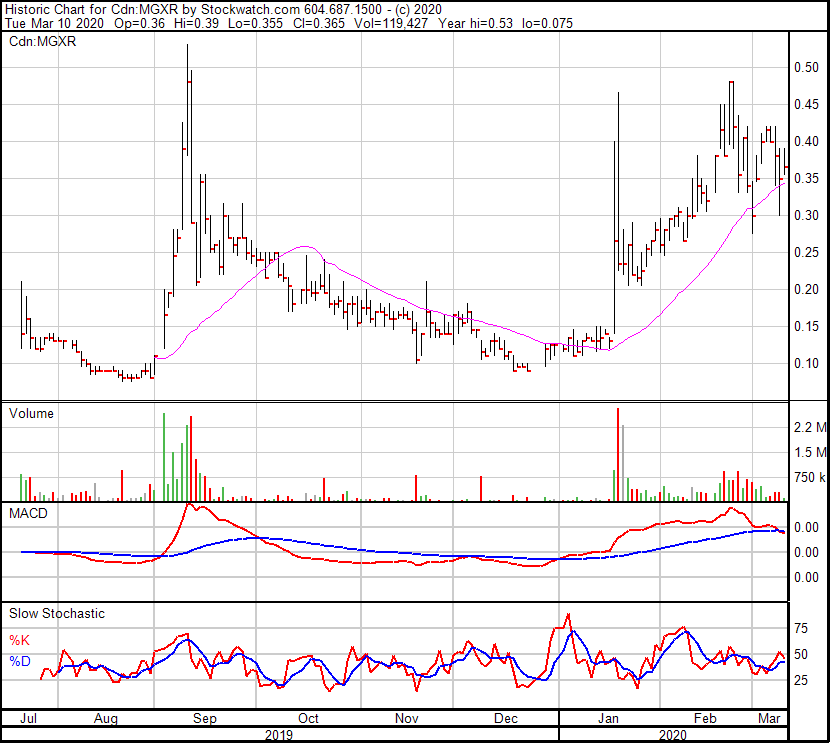Disseminated on behalf of Zinc8 Energy Solutions Inc / MGX Renewables Inc. and Zimtu Capital Corp.
Less than 2 months after the public sector company NYPA (New York Power Authority) announced a Collaboration Agreement with Zinc8 Energy Solutions, a second energy storage deployment contract has now been executed, this time with a private sector company. The $2.5 million CAD project is financially supported by the government agency NYSERDA (New York State Energy Research & Development Authority).
Today, Zinc8 Energy Solutions Inc. is making headlines again as the emerging battery manufacturer announced a second Deployment Agreement for the installation of another 100 kW / 1.5 MWh zinc-air battery for 15 hours of storage.
The New York State Energy Research & Development Authority (NYSERDA) has chosen Digital Energy Corp., and Zinc8 as the energy storage system manufacturer to demonstrate the economics and reliability of Zinc8’s patented zinc-air battery technology for low-cost long-duration storage in a behind-the-meter application in Brooklyn, New York.
The New York State Energy Research & Development Authority (NYSERDA) has chosen Digital Energy Corp., and Zinc8 as the energy storage system manufacturer to demonstrate the economics and reliability of Zinc8’s patented zinc-air battery technology for low-cost long-duration storage in a behind-the-meter application in Brooklyn, New York.
Note that Digital has a pipeline of over 100 potential projects and that according to the Deployment Agreement not only will Zinc8 and Digital work together on the Brooklyn project, but both companies will try to refer other projects to each other for joint proposals. As compensation for referring the Brooklyn project, Zinc8 will grant to Digital options and will make certain payments to Digital in Zinc8 shares on achieving milestones for the Brooklyn project.
Ron MacDonald, Zinc8’s President and CEO, explained the significance of today’s announcement: “This deployment marks a major milestone in Zinc8 Energy Solutions’ path to full commercialization and underscores the growing demand for low-cost reliable long-duration energy storage.”
The contracted 100 kW / 1.5 MWh energy storage system aims to “support and enhance the economics of a CHP system currently operating at Brooklyn, New York”. Digital Energy Corp. is a Brooklyn-based private sector developer of CHP (Combined Heat & Power / Cogeneration) plants, solar systems, and microgrids. The company describes itself as “a premier consulting firm specializing in the energy industry with a focus on cogeneration plant operations and financial performance”, having “extensive experience running CHP plants, negotiating service agreements with support contractors, performing energy efficiency analysis, and financial analysis.”
William Cristofaro, President and CEO of Digital Energy Corp., stated in today’s press-release: “Digital Energy and Integrated Energy Concepts are excited about working with Zinc8 Energy on the development and deployment of the Zinc8 Energy Storage system. The Zinc8 system addresses several critical needs of on-site electric energy storage: Price point economics, system robustness under real-world use, and safety. We see the Zinc8 system as very promising for integration into our existing and developing customer base of over 100 on-site power plants, solar systems, and microgrids.”
Ron Macdonald added: “We are very pleased to be working with the well-respected US interconnect company Digital Energy Corp. who believes, as we do, that this new technology will open up a huge global opportunity for behind-the-meter, microgrid and utility-scale long-duration energy storage.”
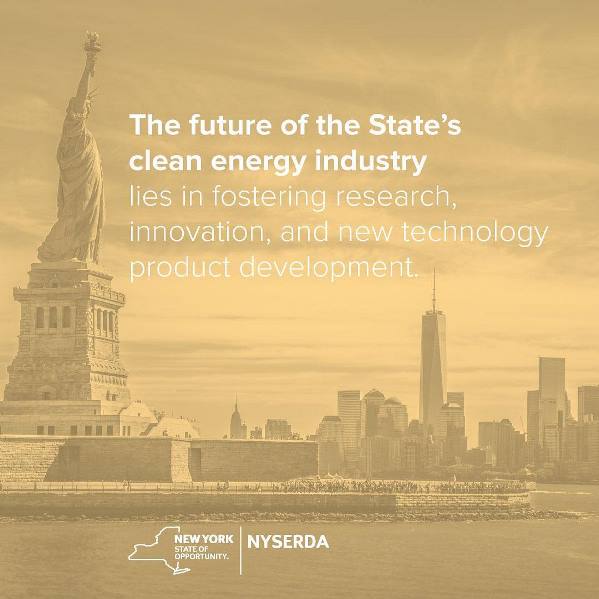
The New York State Energy Research & Development Authority (NYSERDA) is a New York State public-benefit corporation that promotes energy efficiency and the use of renewable energy sources. Collectively, NYSERDA’s efforts aim to reduce greenhouse gas emissions, accelerate economic growth, and reduce customer energy bills. Governed by a 13-member Board, NYSERDA has provided objective information and analysis, technical expertise, and support in New York State since 1975. To learn more about NYSERDA’s programs and funding initiatives, visit www.nyserda.ny.gov or follow NYSERDA on Twitter, Facebook, YouTube, or Instagram.
NYSERDA is a New York State Government agency that has been developing partnerships to advance innovative energy solutions in the Empire State since 1975. On January 29, 2020, NYSERDA announced “a new Co-Investment Fund, making an initial $6 million available for clean energy companies seeking to match investments from qualified investors and stimulate their advancement.” This announcement “supports Governor Andrew M. Cuomo’s Green New Deal, the most aggressive climate change program in the nation, by spurring cleantech innovation to accelerate the green economy”. Alicia Barton, President and CEO of NYSERDA, said: “Emerging cleantech companies are the foundation of New York’s clean energy future, making it critical that we continue providing the support and tools they need to succeed. Investing in new technologies will play an increasingly vital role in our success as Governor Cuomo continues to lead the nation with his ambitious clean energy goals and agenda, and NYSERDA is proud to continue its work making investments and matching investors with New York’s cleantech companies of the future.”
The NYSERDA announcement also noted: “Since 2009, NYSERDA’s overall financial support across its Innovation portfolio has leveraged $1.1 billion in private capital and $349 million in non-NYSERDA grants. From concept to commercialization, NYSERDA administers numerous programs and initiatives through its Innovation portfolio to provide entrepreneurs and early-stage companies access to development partners, investors, and talent. A suite of strategically located resources throughout the state, including clean energy incubators, proof-of-concept centers, manufacturing development sites, and a statewide mentoring program, supports various stages of technology development and commercialization. In total, NYSERDA is deploying $800 million over 10 years to support early-stage companies so they can de-risk technology, validate markets and define customers, and build teams.”
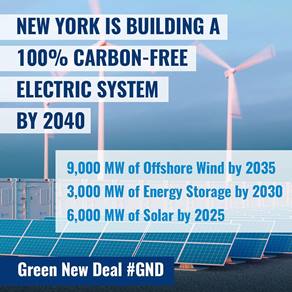

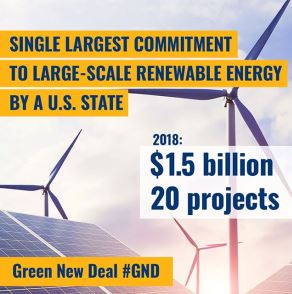
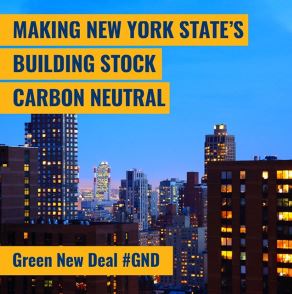

Above images sourced from NYSERDA.
Below excerpts are from the brochure “NYSERDA: Clean energy for the Empire State” as published by Business View Magazine (June 2019):
Currently, there are about 330-350 employees at NYSERDA, with headquarters in Albany, and a presence in New York City, as well as Buffalo. The staff is made up of professionals: engineers, scientists, lawyers, MBAs, accountants – all contributing to the ways the programs are either designed or implemented and ensuring that they are performing the way they need to be. NYSERDA’s primary source of funding comes from the New York State Public Service Commission, which has oversight over utility operations and pricing and ensures that utilities are providing safe, adequate service at just, reasonable rates. The Commission also looks at Governor Andrew M. Cuomo’s policy directives and the most cost-effective means of realizing clean energy policy goals, as well as directing collections to be utilized specifically to support clean energy activities in the clean energy fund. “The Commission also has energy efficiency and other clean energy activities identified and implemented by each of the state’s utilities, so NYSERDA and the utilities work closely to make sure we are all working in the right ways with the various market actors,” [John] Williams [NYSERDA’s Vice President of Policy and Regulatory Affairs] confirms. “Our program portfolio is divided into market development, which is building markets for energy efficiency services, as well as developing renewable energy like wind farms and offshore wind initiatives,” he continues. “The portfolio maintains robust technology research and development activity which is looking at next-generation technologies and how to introduce them to the market when we have technologies working, through early demonstration projects.”
As climate change has become an ever-more-present reality, those environmental drivers have become ever more present in the policies New York has advanced, and those policies have influenced the focus of NYSERDA-based activities. “From technology R&D, to building the scale of clean energy in markets, we have expanded the mission to include technologies for energy services to advance our economic and environmental needs in New York, particularly on climate change imperatives,” adds Williams. “Our mission is to advance innovative energy solutions in ways that improve New York’s economy and environment. Our vision is to serve as a catalyst – advancing energy innovation, technology, and investment; transforming New York’s economy; and empowering people to choose clean and efficient energy as part of their everyday lives.” Another example of developing markets through policy is energy storage and battery technologies. NYSERDA has, for a number of years, looked at in-state battery technology R&D and systems. But to support technology in New York that is now ready for primetime, NYSERDA is organizing around program activity that will be looking at building a battery technology market to scale in New York over the short term. “We have policy directing us to do that: 3,000 megawatts of energy storage by 2030. We’re starting at a relatively low level but we’re designing programs to quickly ramp up and attract customers to utilize those technologies,” Williams claims.
New York’s Green New Deal
According to NYSERDA: “New York State has some of the most aggressive energy and climate goals in the country, including:
• The Clean Energy Standard, a mandate to get 50% of our electricity from renewable sources by 2030, with a proposed expansion to 70%
• A proposed target of 100% carbon-free electricity by 2040
• A 40% reduction in greenhouse gas emissions by 2030 (using 1990 as a baseline)
• Saving 185 trillion BTUs (British Thermal units) in end-use energy by 2030 through greater efficiency
“Energy storage will play a crucial role in meeting these our State’s ambitious goals. Storage will help to integrate clean energy into the grid, reduce costs associated with meeting peak electric demands, and increase efficiency. Additionally, energy storage can stabilize supply during peak electric usage and help keep critical systems online during an outage. All of this while creating an industry that could employ 30,000 New Yorkers by 2030.”
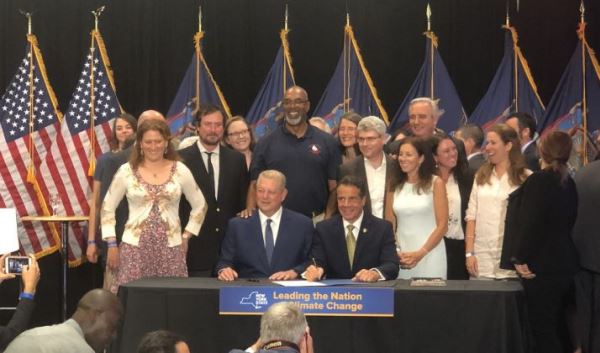
Former Vice President Al Gore joined New York State Governor Andrew Cuomo for the signing of the Green New Deal on July 18, 2019 in New York City. According to NYSERDA: “Governor Cuomo’s Green New Deal is the most aggressive climate change program in the nation and puts the state on a path to being entirely carbon-neutral across all sectors of the economy, including power generation, transportation, buildings, industry and agriculture. The Governor’s program also establishes a goal to achieve a zero-carbon emissions electricity sector by 2040, faster than any state in the nation. The recently passed Climate Leadership and Community Protection Act mandates several of the Governor’s ambitious Green New Deal clean energy targets: installing nine gigawatts of offshore wind by 2035; six gigawatts of distributed solar by 2025 and three gigawatts of energy storage by 2030. The CLCPA also calls for an orderly and just transition to clean energy, creating jobs while spurring a green economy. It builds on New York’s unprecedented ramp-up of clean energy including a $2.9 billion investment in 46 large-scale renewable projects across the state, the creation of more than 150,000 jobs in New York’s clean energy sector and 1,700 percent growth in the distributed solar sector since 2012. The CLCPA also directs New York State’s agencies and authorities to work collaboratively with stakeholders to develop a plan to reduce greenhouse gas emissions by 85 percent from 1990 levels by 2050, and to work toward a goal of investing 40 percent of clean energy and energy efficiency resources to benefit disadvantaged communities.” (Image)
Bottom Line
According to Wood Mackenzie: “The energy storage industry begins the new decade in the midst of a rapid transformation from a niche market to one at the center of the global energy transition. Most grid-scale projects built over the past decade were limited to shorter-duration applications, such as ancillary services for the grid, the ‘lowest-hanging fruit of the storage tree’... [In] the decade ahead ... grid-scale storage will account for the majority of the gigawatts installed...“
Having signed two major deployment contracts within short time “underscores our belief at Zinc8 Energy Solutions that our technology could be transformative in significantly improving the economics of long-duration energy storage”, the company noted in today’s press-release.
While lithium-ion batteries may very well continue to dominate the consumer electronics and electric vehicles industries, utility and grid-scale energy storage often requires a solution that lithium-ion cannot provide.
Lithium-ion batteries are “far too expensive and don‘t last nearly long enough, limiting the role they can play on the grid”. Zinc8’s battery is “inexpensive, made with widely abundant materials, and is easy to dispose of... So that impact on both cost and the handling and ultimate disposal of batteries makes it so that there‘s a reason why folks are really interested to push zinc forward”, said Jason Burwen, Vice President of Policy at the US Energy Storage Association.
Zinc8’s storage system runs on a safe (non-toxic, non-explosive and non-flammable) chemistry. In contrast, lithium-ion batteries can malfunction and cause explosions or fires – a major concern for utilities, especially in densely populated areas such as New York City, and one of the reasons why utilities such as NYPA are “primarily interested in non-lithium ion batteries”.
Lithium-ion batteries are “better suited for limited discharge of about four hours”, whereas Zinc8 targets “discharge for a minimum of eight hours”. Note that Zinc8 today disclosed that both the NYPA and NYSERDA/Digital batteries provide energy storage for 15 hours.
As neither the sun nor the wind produces electricity all the time, or when needed, inexpensive and efficient long-duration storage is the key to effectively integrate renewable energy sources into the grid.
In order for the US to run its electrical grid on 100% wind+solar power, a technological solution would be required capable of storing energy for 3 weeks, according to a scientific paper published in the research journal Energy & Environmental Science (2018).
To run the US grid on 80% solar+wind, 12 hours of energy storage would be required to smooth out the variability of both renewable power sources. An alternative would be building a massive, continental-scale transmission network. As the US currently uses about 3,900 TWh per year, a 12 hour chunk of that would be about 5.4 TWh. John Weaver, a solar power professional and editor at pv magazine USA, looked into these scientific findings and calculated: “At a cost of $350 per kilowatt-hour (kWh), that would cost $1.9 trillion.” However, if the cost was only $45/kWh, total required expenditures would shrink to $243 billion, a landmark cost reduction of 87%.
Recently on February 27, 2020, John Weaver published the article “How zinc-air battery capacity might reach a cost of $45/kWh”, noting the following: “The price of the 100 kW/1 MWh battery the company [Zinc8] is building for the New York Power Authority is confidential, but is projected to be $210/kWh. This first unit will be delivered in a shipping container designed for demonstration and easy inspection access of the hardware. The more important number though is $45/kWh. If the 100 kW/1 MWh system is installed, the cost is $200,000 at $250/kWh. Expanding the system to run for 18 hours straight requires the addition of a single shipping container with 1 MWh of additional capacity. That new capacity will cost an additional $45,000 – or $45/kWh. This is possible because the expensive part of the machine – the cathodes, membranes, and other gear – have already been purchased. One only needs to connect the new shipping container and its very cheap zinc solution ($10/kWh for raw materials) via hoses and pumps... Zinc8 has a long, uphill fight, but it’s fighting in a space – long-term storage – that isn’t really inhabited by anyone yet.”
In other words: There is currently no one who could seriously compete with what Zinc8 has achieved over the last 14 years investing $84 million into its zinc-air battery technology. And if someone actually turns up, Zinc8 may seriously be years ahead in terms of patents, research, development, and commercialization.

Above projections show that the longer the storage duration (hours) the lower the capital costs per kWh of a Zinc8 energy storage system. As John Weaver explained, these costs include the “expensive” parts of the system (cathodes, membranes, etc.), whereafter any further capacity expansion of the system could be achieved at a cost of $45/kWh because essentially only zinc solution ($10/kWh for raw materials) must be added to the system via hoses and pumps.

Full size / Images from Zinc8 Energy Solutions Inc.
Last Friday, on March 6, 2020, Zinc8 was mentioned in the Bloomberg article “Meet Zinc, the Cheap Metal Gunning for Lithium’s Battery Crown“. Some notable excerpts include: “A metal best known for galvanizing steel is making the jump into a developing $30 billion energy-storage market for electrical grids that’s increasingly seen as key to unleashing solar and wind power upon the world... ‘Storage for utilities is an untapped market,’ said Ron MacDonald, the head of Zinc8 Energy Solutions, the company that won the state challenge. ‘It’s a holy grail.’ ... The company goal, according to MacDonald: ‘Go through testing in different scenarios where we can efficiently add our batteries’ to different types of grids. The New York project ‘opens the door for Zinc8 to deploy its technology into the broader utility market,’ he said... ‘There’s no question lithium and lead-acid batteries currently dominate the energy storage market,’ said Andrew Green, Executive Director at the International Zinc Association. ‘But we’re the upcoming group.’”
For utility and grid-based storage, the core problem with lithium-ion and other types of zinc-air batteries (e.g. NantEnergy) is that its chemistries do not decouple energy (kWh) and power (kW). The energy is typically stored inside the electrode and, as a result, the overall energy capacity is limited by the total geometric surface area of the electrode. This means that the cost for each added kWh technically remains the same/fixed, making scale-up very costly. By contrast, Zinc8 decouples energy and power, a feat that opens up manifold opportunities in both cost saving (incremental energy cost of $45/kWh) and field applications.

“Proven Competitive Advantage: Unlike lithium-ion technology, which requires new stacks in order to scale, Zinc8 has completely decoupled the linkage between energy and power. This means that scaling Zinc8’s technology can be accomplished by simply increasing the size of the fuel tank and quantity of recharged zinc fuel.” (Source)
By definition, Zinc8’s contracted 100 kW / 1.5 MWh storage systems can dispatch 100 kW of power instantaneous to all the demand appliances connected to the storage module. When you divide the energy capacity (1,500 kWh, or 1.5 MWh) by the power rating (100 kW), you get the duration (15 hours) that the system can operate while delivering its rated output. This duration is the energy-to-power ratio, also called the discharge time. Therefore, Zinc8’s 100 kW / 1.5 MWh battery can provide energy storage for 15 hours. If longer durations are needed, simply add energy capacity.
In this respect, note the short storage duration of the 3 recently deployed zinc-air batteries from privately-held, Arizona-based NantEnergy Inc.: (1) Vitality Works: 162 kWh / 120k W = 1.35 hours of storage; (2) Hokto Kinoko: 405 kWh / 300 kW = 1.35 hours of storage; (3) City of Del Mar: 121.5 kWh / 30 kW = 4.05 hours of storage. NantEnergy’s battery design stores energy within the electrode, which defines/limits the amount of energy a single cell is able to store. As the cell also defines/limits the power output, NantEnergy therefore cannot decouple energy and power as both are limited by the geometry of the electrode.
The zinc-air battery design from privately-held, Toronto-based e-Zn Inc. “is particularly suitable for off-grid and micro-grid applications”, the company states on its website; e.g. targeting the replacement of diesel generators; e.g. at remote communities such as Canada’s Indigenous North, following a recent grant from the Canadian Government. The configuration of e-Zn’s storage system is such that the top set of cells is the zinc regenerator and the bottom set are fuel cells. From a product or application standpoint, it’s true that e-Zn can increase the energy capacity by only increasing the volume of the tank (very similar to Zinc8). However, as opposed to Zinc8’s design, e-Zn’s cell stacks are not modular. If a customer wants to decrease the recharge time or increase charge capacity, e-Zn will have to find space within the tank to install additional zinc regenerators. If a customer wants to increase power output, e-Zn will have to find space for additional fuel cells at the bottom of the tank. In other words, e-Zn’s system modularity is limited by the tank size. By contrast, Zinc8 has stand-alone stacks for each function – this is true modularity, and just one of many examples why Zinc8’s design is superior.
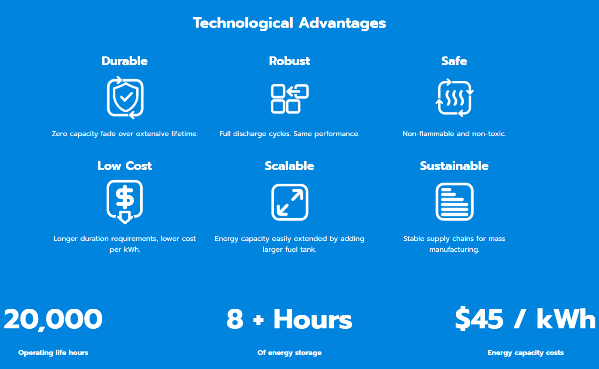
Full size / Image from Zinc8 Energy Solutions Inc.

The Bloomberg article “Meet Zinc, the Cheap Metal Gunning for Lithium’s Battery Crown“ is also available in Spanish, Portuguese, and Polish.
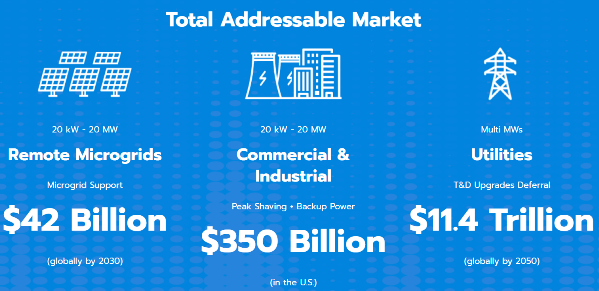
Full size / Image from Zinc8 Energy Solutions Inc.
Recently, Advance Market Analytics released its new comprehensive market study Global Regenerative Fuel Cell including Zinc8 as a “key player” under coverage.
Interview with Ron MacDonald: Redefining Long-Duration Energy Storage

Ron MacDonald, President, CEO and Director of Zinc8 Energy Solutions Inc. For more details on his background, visit Wikipedia.
Q. What is your current view of the energy storage market globally and what are the drivers of growth in this market?
A. We are seeing an accelerating growth of renewables worldwide to solve our climate crisis problem. Efficient and economic energy storage is the solution for solving the intermittency of wind and solar energy resources, as well as increasing the efficiency of transmission and distribution on the grid. Up until now, we have used existing short-duration technologies, such as lithium-ion and gas peaking plants to try and balance the grid. However, with the rapid movement away from GHG producing power generation and the move towards electrification of the world’s billions of vehicles, there is a need for new, innovative and cost-effective 8+ hrs. long-duration energy storage. We at Zinc8 Energy Solutions believe we are that technology.
Q. Tell us about Zinc8 Energy Solutions and its Zinc-Air Battery Technology
A. Zinc8 Energy Solutions represents a team of engineers who have put more than a decade of work in making the battery of the future. Simply put, it took a lot of time, dedication and innovation to get to where we are today, the lowest cost long-duration battery in the market. After many iterations to our technology, we have developed a battery that uses abundant and affordable materials, which provides flexibility and scalability without volatile or controversial supply chains. Our battery’s architecture provides the same flexibility of redox flow batteries, but at a fraction of the cost.
Q. What makes your Zinc8 ‘Zinc-Air Battery’ technology unique in the global marketplace?
A. The long-duration energy storage market is new and there are a number of innovative and interesting technologies currently under development to address this market. Unfortunately, many of them still have technical and cost limitations that need to be addressed in order to become a viable economic solution at this time. Zinc8 Energy Solutions is bringing to market a battery that can serve a wide range of storage durations on a flexible scale, from kilowatts to the order of megawatts. Our technology is mature, and our economics allow support the expansion of the long-duration storage market.
Q. What segments of the market do you think will be the first to adopt your technology?
A. Long-duration storage provides economic value at all levels of the electric grid, such as in front or behind-the meter applications, islanded microgrids and maximizing the efficiency of transmission and distribution systems. I believe it is too early to guess which applications will be the first adopters, but the interest shown and commitment to long duration storage goals by utility companies like the New York Power Authority (NYPA), would suggest a rapid escalation of investments into this sector.
Q. Explain your strategy for taking Zinc8 Energy Solutions from pre-commercialization to volume manufacturing?
A. We believe the early deployments in our collaboration with NYPA and other partners, will provide the data required for the financial markets to support the investments essential to building out our fabricating and manufacturing facilities over the next 24 - 36 months.
Q. You recently announced a collaboration to deploy your Zinc-Air Battery in New York State with The New York Power Authority, explain the significance of this collaboration for Zinc8 Energy Solutions.
A. The significance is that this award was won through a competitive process for non-lithium 8+hrs energy storage solutions. As the winner of the New York Power Authority’s Innovation Challenge, Zinc8 Energy Solutions in collaboration and with financial support from NYPA will deploy the first use of a Zinc-Air Energy Storage System in New York State. For a small company such as Zinc8 Energy Solutions to be selected by the largest public and most progressive Power Authority in the United States, validates both our technology and our belief that the long-duration energy storage market presents a new trillion-dollar opportunity for a company like ours to participate in. (Source: Zinc8 Energy Solutions Inc., February 19, 2020)

Previous Coverage
Report #4: “Visiting the Zinc8 Energy Storage Development and Production Facility: The Dawn of the Utility-Scale Battery Era“
Report #3: “The Largest State-Owned Power Utility in the USA Announces Collaboration with Zinc8 Energy Solutions“
Report #2: “Reborn as Zinc8 Energy Solutions“
Report #1: “Bridging the Renewable Energy Infrastructure Gap“
Company Details

Zinc8 Energy Solutions Inc. (dba) /
MGX Renewables Inc.
#1 – 8765 Ash Street
Vancouver, BC, Canada V6P 6T3
Phone: +1 604 558 1406
investors@zinc8energy.com (Patrick)
www.zinc8energy.com
ISIN: CA59325P1080 / CUSIP: 59325P108
Shares Issued & Outstanding: 75,711,374
Canada Symbol (CSE): MGXR
Current Price: $0.365 CAD (03/10/2020)
Market Capitalization: $28 Million CAD
Germany Symbol / WKN (Tradegate): 0E9 / A2PNN3
Current Price: €0.241 EUR (03/10/2020)
Market Capitalization: €18 Million EUR
Contact:
Rockstone Research
Stephan Bogner (Dipl. Kfm.)
8260 Stein am Rhein, Switzerland
Phone: +41-44-5862323
Email: info@rockstone-research.com
www.rockstone-research.com
Disclaimer: This report contains forward-looking information or forward-looking statements (collectively "forward-looking information") within the meaning of applicable securities laws. Forward-looking information is typically identified by words such as: "believe", "expect", "anticipate", "intend", "estimate", "potentially" and similar expressions, or are those, which, by their nature, refer to future events. Rockstone Research, Zinc8 Energy Solutions Inc. / MGX Renewables Inc. and Zimtu Capital Corp. caution investors that any forward-looking information provided herein is not a guarantee of future results or performance, and that actual results may differ materially from those in forward-looking information as a result of various factors. The reader is referred to the iZnc8 Energy Solutions Inc. / MGX Renewables Inc.´s public filings for a more complete discussion of such risk factors and their potential effects which may be accessed through their profiles on SEDAR at www.sedar.com. Please read the full disclaimer within the full research report as a PDF (here) as fundamental risks and conflicts of interest exist. Zinc8 Energy Solutions Inc. / MGX Renewables Inc. pays Zimtu Capital Corp. to provide this report and other investor awareness services.The author, Stephan Bogner, holds a long position in Zinc8 Energy Solutions Inc. / MGX Renewables Inc. and is being paid by Zimtu Capital Corp. for the preparation and distribution of this report, whereas Zimtu Capital Corp. also holds a long position in Zinc8 Energy Solutions Inc. / MGX Renewables Inc. The cover picture, displaying a view from Manhattan to Brooklyn, has been obtained from Renata Ty and the last picture of a sunrise over New York City has been obtained from bbernard.

